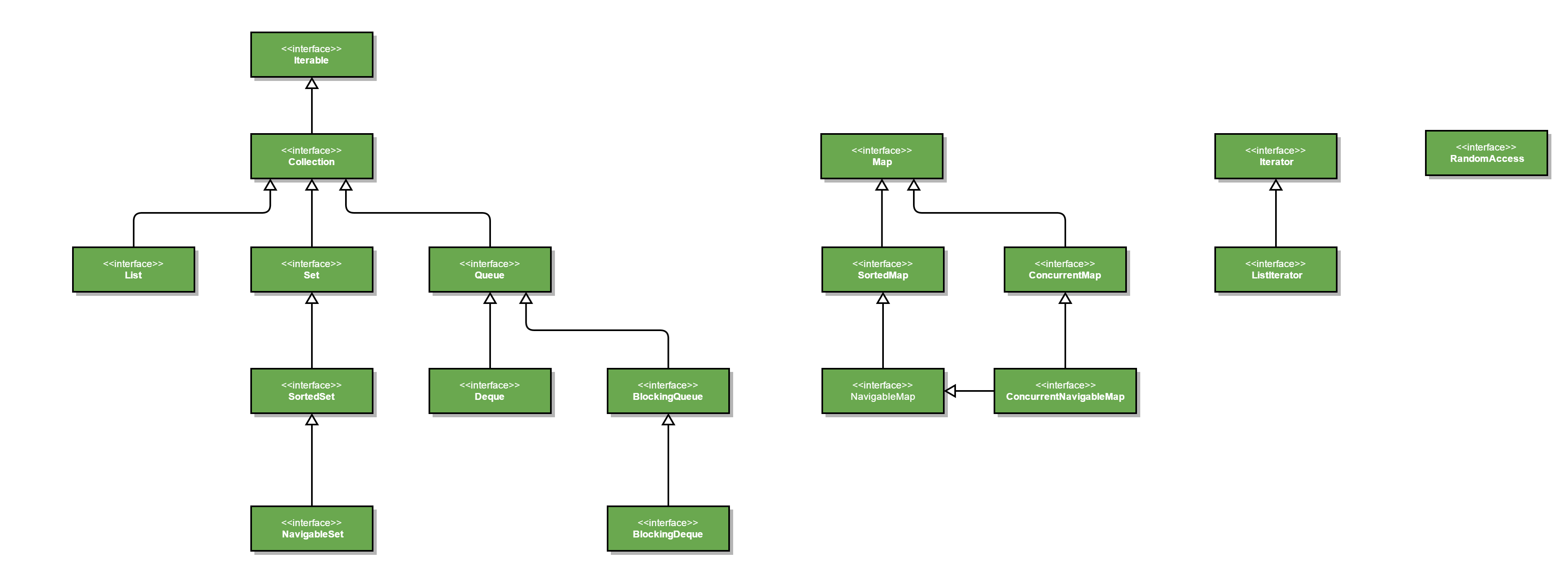什么是集合
在 Java 中,集合表示一组对象,这些对象也称为集合的元素。
使用集合框架的好处
通过 API 文档,我们不难发现,其实在 JDK 1.0 的时候,只包含了很少的集合类(例如:Vector ,Stack ,Array ,Hashtable ),
然而,集合的应用场景非常广泛,因此,在 JDK 1.2 的时候由大牛 Josh Bloch 设计并实现的集合框架便应运而生了。
使用 JDK 提供的集合框架,主要好处如下:
- 减少开发成本,不用开发者再造“轮子”。
- JDK 提供的集合类都经过了良好的测试,在代码质量和性能上都有所保证。
- 提供了一套接口标准,为不同开发者提供了一种“共同的语言”。
集合框架的层次结构
Java 的集合框架主要有两大接口: Collection 和 Map 。
Collection用于存放一组对象(多个单对象),Map用于存放键值对。Collection中常用的有List和Set。List允许放入相同的对象,而Set不能。List接口常用的实现类有:ArrayList、LinkedList、Vector和Stack。Set接口常用的实现类有:HashSet、TreeSet。
Map接口常用的实现类有:HashMap、TreeMap。
两大接口的层次结构:
- java.util.Collection
- java.util.Set
- java.util.SortedSet
- java.util.NavigableSet
- java.util.Queue
- java.util.concurrent.BlockingQueue
- java.util.concurrent.TransferQueue
- java.util.Deque
- java.util.concurrent.BlockingDeque
- java.util.Map
- java.util.SortedMap
- java.util.NavigableMap
- java.util.concurrent.ConcurrentMap
- java.util.concurrent.ConcurrentNavigableMap
集合框架接口层次结构:

集合框架类层次结构:

主要的接口和实现类
| Interface | Hash Table | Resizable Array | Balanced Tree | Linked List | Hash Table + Linked List |
|---|---|---|---|---|---|
| Set | HashSet | TreeSet | LinkedHashSet | ||
| List | ArrayList | LinkedList | |||
| Deque | ArrayDeque | LinkedList | |||
| Map | HashMap | TreeMap | LinkedHashMap |
List
List 是有序的集合,这个有序不是指集合里面的元素是按值排序的,而是指这些元素存储的位置是有序的。更确切地讲,用户可以把元素添加到指定的位置。
ArrayList
ArrayList 是一个动态数组,默认是空的,相当于 {}。add 操作会自动扩充容量,默认容量为 10 。
当 ArrayList 的容量即将超出限制时,会自动扩充:
1 | private void grow(int minCapacity) { |
简单来说,就是扩大为当前容量的 1.5 倍。
其中:minCapacity 为当前容量 + 1 ,最大容量为 Integer.MAX_VALUE 。
从实现的代码可以知道,扩容的时候,需要将现有的元素复制到新数组中。因此,当元素很多的时候,这个复制操作是很昂贵的。
因此,在添加大量元素前,建议使用 ensureCapacity() 方法来增加 ArrayList 的容量,以减少递增式扩容的开销。
add(E) 和 add(int, E) 的主要区别在于, add(int, E) 需要把 index 和它后面的元素向后移动一位。
1 | public void add(int index, E element) { |
remove(int) 不需要通过遍历来查找对象,因此,性能会比 remove(Object) 要好。
但是,不管怎么样,都需要通过 System.arraycopy() 来移动受影响的元素。
1 | public E remove(int index) { |
对应 ArrayList 而言,由于它使用数组实现,节约空间,并且可以通过索引高效地获取元素(get(int) / set(int, E)),其主要缺点在于,增删操作性能较差。
LinkedList
LinkedList 是一个双向链表。
链表没有容量限制,但双向链表的实现需要占用更多的空间,也需要额外的链表指针操作。
1 | private static class Node<E> { |
add 操作相对 ArrayList 就简单很多,不用考虑复制数组的问题,只需要修改前后节点的引用即可:
1 | void linkLast(E e) { |
get 操作则比较麻烦,需要遍历,不过 Josh Bloch 也做了一点优化:
1 | Node<E> node(int index) { |
Map
Map 以键-值对的方式存放元素,也有人称之为:映射表。
一个 Map 中不能包含有重复的键,每个键最多只能映射到一个值。
至于 Map 为什么没有继承自 Collection (能不能把 Map 视为键-值对的集合,或者视为用键作为索引的值的集合)?
官方给出的解释是:
我们认为映射(mappings)不是集合(collections),集合也不是映射。因此,
Map继承Collection接口没有意义,反之亦然。
如果Map是一种Collection,那么它的元素是什么呢?唯一合理的答案是“键-值对”,但是,这样一来就只能提供一种非常有限的(没什么用的)映射抽象。你不能按键取值,也不能仅仅依据键来删除元素(因为不知道这个键映射的值)。
如果Collection继承自Map,这又会引发另一个问题:什么是键?没有令人满意的答案。这样的设计会被迫出现一个不自然的接口。
事实上,可以将Map看作是Collection,这体现在Map提供了三种(键、值、键-值对)Collection视图(允许以键集 KeySet 、值集合 values 或键-值映射关系集 EntrySet 的形式查看某个Map的内容)……
HashMap
对于 HashMap 的理解,重点在于理解它的结构和插入操作。HashMap 基于数组实现,数组中存放链表或者是红黑树(在 JDK 1.8 中,如果链表长度超过阀值[8],则会把链表转换成红黑树)。而这些链表以及红黑树又有人称之为桶(bucket)。
大概是长成这个样子的:

核心代码:
1 | // 数组 |
插入元素时,首先会先对 key 对象进行 hash 操作,然后根据 hash 值定位到具体的桶。
如果 hash 相等,并且 key 相同,则覆盖旧值,并返回旧值。
如果 hash 相等,但是 key 不同,就产生了所谓的“ Hash 冲突”。
解决 Hash 冲突通常有两种方法:开放地址法和链表法。
- 开放地址法会通过一个探测算法,当某个桶位已经被占据的情况下继续查找下一个可以使用的桶位。
- 链表法则会将相同 hash 值的对象组织成一个链表放在 hash 值对应的桶位。
HashMap 的实现采用的就是链表法:
1 | // hash 操作 |
其实不管是 put 操作还是 get 操作,首先要做的就是定位,也就是找到对象存储的地址。
因此,既要考虑计算的性能,又要尽量避免冲突。HashMap 的做法是:
1 | i = (n - 1) & hash |
这种实现假定哈希函数能够将元素离散地分布在各桶之间,因为只有这样才可为 get/put 之类的操作提供稳定的性能。
关于 HashMap 的性能,影响的参数有两个:初始容量 和 加载因子 。
- 容量是指
HashMap中能够填充的桶的最大数量,初始容量即创建时的容量(默认为 16 )。 - 加载因子可以理解为填充比(默认为 0.75f ),是一个阀值,当
HashMap中桶的数量大于加载因子与容量的乘积时(0.75f * 16),就要对该HashMap进行 resize 操作。
不难看出:
如果把加载因子设置得高一些,就可以节约空间,但同时又会增加查询成本。
如果初始容量设置太小,又会导致 resize 操作,因此,如果需要自定义参数,应考虑到需要存储的对象数量。
TreeMap
TreeMap 是一个基于红黑树(Red-Black tree)的 NavigableMap 实现,支持按 key 排序。
可以通过 firstKey() ,lastKey() 取得最大最小的 key 。
还可以通过 subMap(K fromKey, K toKey) ,tailMap(K fromKey) 获得子集视图。
TreeMap 的 put 操作会从根节点开始判断,基于 compare 的值来决定元素放在树的左边还是右边,如果找到相等的 key ,那么就直接替换为新值,如果一直找不到,则创建一个新的 Entry 对象。
1 | public V put(K key, V value) { |
TreeMap 的 containsKey、get、put 和 remove 操作时间开销为:log(n) 。
Set
Set 是一个不包含重复元素的集合。
为什么先学习 Map ?
是因为 Set 的子类的几乎都是基于特定的 Map 实现的。
前面我们可以看到 Map 的键集视图 KeySet 就是一个 Set 。
HashSet
HashSet 的内部实现是 HashMap ,使用 key 保存元素,而 value 则统一使用一个常量填充。
1 | private transient HashMap<E,Object> map; |
TreeSet
TreeSet 的内部实现是 TreeMap ,类似的,也是使用 key 保存元素,而 value 则统一使用一个常量填充。
1 | private transient NavigableMap<E,Object> m; |
Deque
Deque 是 “double ended queue(双端队列)” 的缩写,通常读为 “deck” 。Deque 继承自 Queue ,支持 FIFO(先进先出)操作,也可用作 LIFO(后进先出)堆栈,并且 API 文档中建议我们优先使用此接口而不是使用遗留 Stack 类。
ArrayDeque
ArrayDeque 基于循环数组实现。没有容量限制,可以按需扩展。
用作堆栈时快于 Stack ,在用作队列时快于 LinkedList 。
1 | transient Object[] elements; |
LinkedList
LinkedList 以双向链表实现,既是 List ,也是 Queue 。
它是唯一一个允许放入 null 的 Queue 。
1 | transient Node<E> first; |
遍历操作
集合
Iterator
Iterator 是集合的迭代器。
需要注意的是,它的光标位于两个元素之间,因此:
调用 Iterator.next() 前,一般先判断 Iterator.hasNext() 。
而调用 Iterator.remove() 前,则需要先调用 Iterator.next() 。
可以这么理解:每一次调用 Iterator.next() 都会 “消耗掉” 一个元素(和 InputStream.read() 类似)。
1 | ArrayList<String> aList = new ArrayList<>(); // JDK 1.7 菱形语法 |
对于 List 还有更强大的 ListIterator 可以使用。Iterator 只能进行正向的遍历,而 ListIterator 则允许按任一方向遍历,并且,还支持 add 、set 操作:
1 | ArrayList<String> aList = new ArrayList<>(); |
Enumeration
在 JDK 1.2 以前,还没有 Iterator 接口,需要使用 Enumeration 进行枚举:
1 | Vector<String> aVector = new Vector<>(); |
相对于 Enumeration ,Iterator 更安全。
因为 Iterator 对集合进行遍历时,会阻止其它线程对当前集合进行结构性的修改(例如:add、remove操作,会抛出 ConcurrentModificationException ),也就是所谓的 “快速失败(fail-fast)” 。
并且,Iterator 允许从集合中删除元素,方法名也更短。
foreach
由于 Collection 接口继承自 Iterable 接口,因此它的子类都支持 “foreach” 语句:
1 | ArrayList<String> aList = new ArrayList<>(); |
Map
至于 Map 的遍历,一般是先获取 Map 的集合视图再进行遍历:
1 | HashMap<String, String> map = new HashMap<String, String>(); |
工具类
Collections
Collections 类封装了对集合操作的各种静态方法和常量:
- addAll()
- binarySearch()
- fill()
- sort()
- checkedXxx()
- synchronizedXxx()
- unmodifiableXxx()
Arrays
Arrays 类包含用来操作数组(比如排序和搜索)的各种方法:
- binarySearch()
- copyOf()
- copyOfRange()
- fill()
- sort()
- parallelSort()
- parallelPrefix() // JDK 1.8
- setAll() // JDK 1.8
- parallelSetAll() // JDK 1.8
- spliterator() // JDK 1.8
- stream() // JDK 1.8
与 Collection 的 toArray() 方法相对,Arrays 类提供了 asList() 方法:
1 | List<String> stooges = Arrays.asList("Larry", "Moe", "Curly"); |
并发编程
Java 集合框架中大部分的类都是非线程安全的,对于集合的并发编程,要么自己通过锁来控制它们的读写操作,要么使用 Java 自身提供的线程安全的集合类来解决。
以 List 为例,ArrayList 的实现不是线程安全的,而古老的 Vector 是线程安全的。
但是, Vector 的锁的粒度很大(它的方法基本上都加了 synchronized ),每次读写操作都会把列表中的所有元素锁住,产生互斥,这种开销是非常大的。
为了解决这个问题,Java 提供了一种 CopyOnWrite 机制:使得读操作始终能够并发执行,而写操作则是先拷贝一份数组出来修改,等修改完成后,再将它赋给内部的数组引用。
1 | public boolean add(E e) { |
CopyOnWrite 机制对 “读多写少” 的场景是非常适用的,但是如果需要频繁的写操作,可能还不如自己直接加锁处理。
对于 Map ,Java 并没有提供 CopyOnWriteHashMap ,而是使用 “锁分段” 技术实现了 ConcurrentHashMap 。
其主要原理就是:首先将容器中的数据进行分区,分成一个个的片段( Segment ,默认大小为 16),然后再给每一段数据配一把锁,当一个线程访问其中一个段数据的时候,只会占用当前片段的锁,而其他段的数据也就能被其他线程所访问。
这样一来,可以减少锁的竞争,并且内在的拷贝操作也不用占用太大的内存。
本质上就是为了减小锁的粒度。
除此之外, java.util.concurrent 包还提供了很多在并发编程中常用的工具类。
例如:
- CopyOnWriteArrayList // 并发优化的 ArrayList
- CopyOnWriteArraySet // 并发优化的 ArraySet
- ConcurrentHashMap // 并发优化的 HashMap
- ConcurrentSkipListMap // 并发优化的 SortedMap
- ConcurrentLinkedQueue // 并发优化的 Queue
- LinkedBlockingQueue // 并发优化的 BlockingQueue
- ArrayBlockingQueue // 并发优化的 BlockingQueue
这里暂时不再展开,后续再做研究。
更多内容
Guava
Guava 是 Google 的出品的一个类库,包含:集合 [collections] 、缓存 [caching] 、原生类型支持 [primitives support] 、并发库 [concurrency libraries] 、通用注解 [common annotations] 、字符串处理 [string processing] 、I/O 等内容。
其对集合框架的增强和扩展算是 Guava 最成熟和流行的部分之一。
在这里,只列举几个小例子,更多内容,可以到项目主页上去深入了解、学习。
1 | // 能够推断范型的静态工厂方法 |
谣言
另外,网上还有一些文章在传:“ JDK 1.7 在语法层面上支持集合”,看上去挺美的。
然而,实际情况却是:这个语言特性目前仍未实现!
也许在后续的 JDK 版本(Java 9+ ?)中会实现,但是,以下代码在目前可用的 JDK 版本中无法编译通过的:
1 | // 以下代码无法编译通过 |
总结
对于集合框架的使用,最关键的是要明确应用场景。
不妨考虑以下几个问题:
- 是否使用数组就可以满足需求?
- 是 Collection ?还是 Map ?
- 是否允许存储相同的对象?
- 是否需要存储 null ?
- 是否需要对集合中对象进行排序?
- 是否需要进行有序的迭代?
- 是更关注写操作( add/put/remove )的效率?还是读操作( get/contains )的效率?
- 是否需要保证线程安全?
参考文档
- Java Tutorials:https://docs.oracle.com/javase/8/docs/technotes/guides/collections/index.html
- Java SE API Documentation:http://docs.oracle.com/javase/8/docs/api/index.html
